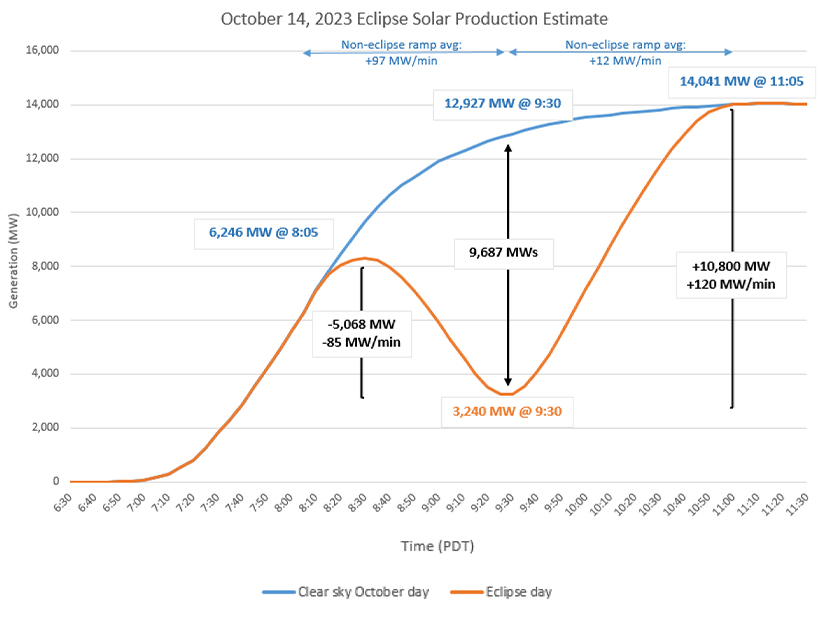
CAISO is planning ahead for a solar eclipse that will abruptly slash solar power across much of California the morning of Oct. 14.
CAISO successfully managed the drop in solar output during a total eclipse on Aug. 21, 2017. But since then, grid-scale solar within the CAISO footprint has increased from 10,000 MW to 16,500 MW. (See Grid Operators Manage Solar Eclipse.)
And behind-the-meter solar has grown from 5,700 MW to 14,350 MW.
“The October 2023 eclipse will be more impactful than the 2017 eclipse because of the growth in solar capacity since 2017,” CAISO said in a technical bulletin issued last week.
In response, CAISO has scheduled a series of meetings — including a workshop on Sept. 5.
Outreach to Western Energy Imbalance Market entities is planned, as CAISO said coordination across the WEIM is critical to ensure optimal market dispatch during the eclipse.
CAISO is planning additional reserve procurement, a step it also took to prepare for the 2017 eclipse. The ISO will consider restricting maintenance operations around the time of the eclipse, to reduce the risk of an “inadvertent issue” occurring during maintenance work.
Another option would be to implement a Flex Alert or activate demand response programs during the eclipse. CAISO said it probably won’t need to do that, “due to the eclipse occurring on a weekend when loads are typically lower.”
Blocking the Sun
During the so-called Great American Eclipse in August 2017, grid-connected solar generation in CAISO territory dropped by more than 3,500 MW in about an hour. CAISO replaced the lost solar power with electricity from imports, hydropower and natural gas power plants. Consumers conserved electricity during the eclipse to relieve stress on the grid.
The 2017 eclipse was on a Monday, from about 9 a.m. to noon in California.
In contrast to that eclipse, the event on Saturday, Oct. 14, will be an annular eclipse, in which the moon will block much of the sun but leave an outer ring.
Large parts of Oregon, Nevada, Utah and New Mexico, and small parts of California and Arizona, will see the maximum impact of next month’s eclipse, with about 90% of the sun obscured. Much of California will see lesser amounts of sun obscuration, in the 70% to 80% range.
The Oct. 14 eclipse will last from about 8:05 a.m. to 11 a.m. in CAISO territory. At the peak, around 9:30 a.m., grid-scale solar generation will drop to 12% to 23% of capacity, CAISO said. Solar production won’t be completely cut off, but will fall to a low of about 3,023 MW at 9:26 a.m.
Output will also be reduced for behind-the-meter rooftop solar, leading to increased load. The maximum impact to load will be a 4,843-MW increase at 9:15 a.m., compared with normal clear-sky conditions, according to CAISO’s forecast.
Because the eclipse will occur on a Saturday, loads will be lighter than they would be on a weekday.
Ramp-up Concerns
One of CAISO’s concerns is the steep ramp up in solar power after the eclipse peaks. The eclipse will end just as solar sites are reaching their midday production maximum, the ISO noted.
“The period after the eclipse maximum to the end of the eclipse … is the period of operational interest the CAISO will study to ensure adequate supplies of generation [reserves] are available to mitigate any adverse effects of the anticipated steep up-ramp in solar production,” CAISO said in its technical bulletin.
CAISO said it will coordinate with hydro and battery resources to help with potentially large ramps.
The bulletin models eclipse impacts on a clear-sky day, which CAISO said represents a “high impact” scenario. Impacts will be less if Oct. 14 is a cloudy day.
CAISO plans to send out messages through its market notification system before and during the event.
“This message is to serve as a reminder that the solar eclipse will take place on Oct. 14, 2023, from 8:05 to 11:05 PDT,” one sample message reads. “This is a unique event for the ISO BA, during which approximately 9,700 MW of solar generation will rapidly go away and then return within the span of less than three hours. Your cooperation and support throughout the event will help to ensure grid reliability.”


